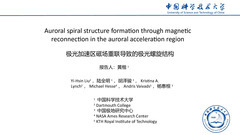报告详情
Auroral Spiral Structure Formation Through Magnetic Reconnection in the Auroral Acceleration Region
编号:154
访问权限:私有
更新:2023-04-07 17:33:42 浏览:628次
口头报告
摘要
Discrete aurorae, usually displayed as auroral arcs, are universal phenomena in the ionosphere of the Earth and other planets, and are generated by precipitations of electrons from the magnetosphere, ionosphere, and solar wind. Spirals, as frequently observed vortex structures in arcs, have drawn great attention. The formation of auroral spirals is considered to be related to the magnetosphere-ionosphere coupling process during both magnetically active and quiet times. However, how the auroral spirals develop is still an open question. Here, we propose a model to explain the formation of auroral spiral structure based on three-dimensional particle-in-cell simulations. In our model, an auroral arc develops through precipitations of electrons accelerated during magnetic reconnection in the auroral acceleration region, which is typically above ∼4000 km altitude in the field-aligned current sheet. The arc morphology at low altitudes can be modified by electron-scale magnetic flux ropes, which are generated through secondary oblique tearing modes in the intensified current sheet along one particular branch of the primary reconnection separatrices. The resulting vortex structures agree well with high-resolution observations of auroral spirals. We find that the rotational sense of these spirals is determined by electron kinetic processes and controlled by the guide field direction. Our study further suggests that when the field-aligned length of the auroral acceleration region is shorter than a critical length, these auroral spiral structures will not form.
关键词
magnetic reconnection,auroral spiral
报告人

黄楷
中国科学技术大学稿件作者
全部评论
重要日期
-
会议日期
05月05日
2023
至05月08日
2023
-
03月31日 2023
初稿截稿日期
-
05月25日 2023
注册截止日期
主办单位
青年地学论坛理事会
中国科学院青年创新促进会地学分会
中国科学院青年创新促进会地学分会
承办单位
武汉大学
中国科学院精密测量科学与技术创新研究院
中国地质大学(武汉)
中国科学院精密测量科学与技术创新研究院
中国地质大学(武汉)



发表评论